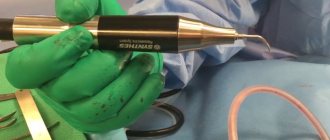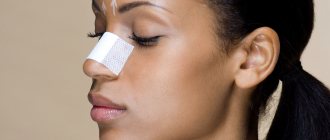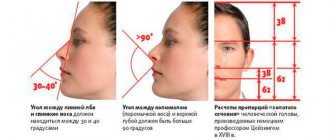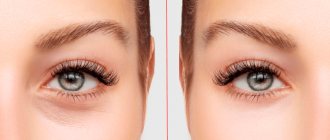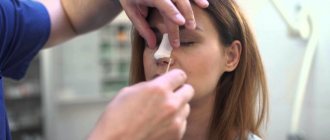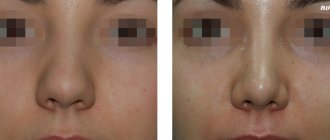The result of an operation performed in a plastic surgery clinic and aimed at correcting various nasal defects can upset the patient.
Doctors do not always succeed in achieving their goal, and in some cases the intervention is related to the elimination of the consequences of severe injuries and is carried out in two or even three stages.
The patient has to come to terms with the fact that after a certain time after the completion of the rehabilitation period, he will need revision rhinoplasty.
A secondary operation will allow you to get rid of minor errors, which are acceptable in the opinion of most experts, and from serious mistakes of a doctor who does not have sufficient qualifications, experience and work experience in this field.
This surgical intervention is performed to eliminate defects resulting from incorrect rhinoplasty, which led to:
- Deterioration of aesthetic appeal.
- The appearance of significant asymmetry of the nostrils.
- Difficulty breathing.
- Constant dryness of the mucous membranes.
- Impaired functionality of the external respiratory organ.
Secondary rhinoplasty is permitted in a modern plastic surgery clinic using the latest equipment. The operation is performed by a highly qualified doctor who enjoys the trust of colleagues and patients.
The professionalism of the surgeon who is to perform revision rhinoplasty is of great importance, since correcting other people’s mistakes requires a high level of skill.
If primary rhinoplasty is necessary to eliminate defects that arose after suffering a complex disease or resulting from injury, then reoperation is a means of getting rid of complications that made themselves felt during the rehabilitation period or after it.
Such an intervention is considered a procedure of increased complexity. This is due to the need for correction in cases of identifying the consequences of incorrect installation of implants, removal of too much cartilage tissue, or displacement of the nasal septum.
Often, plastic surgeons have to eliminate the consequences of operations performed on an outpatient basis (in beauty parlors or beauty salons).
Despite the fact that with the help of secondary rhinoplasty it is possible to correct a large number of previously made mistakes, corrective intervention does not guarantee a 100% positive result for those patients who, during the first rhinoplasty, had a significant amount of bone or cartilage tissue removed, noticeable gaps formed, asymmetry of the nostrils or wings of the nose has appeared.
Which noses are classified as “complex”?
- Noses that were repeatedly broken.
- Noses that “resulted” from unsuccessful corrections in other clinics.
- Deformation of the nose due to increased scarring.
- Genetically determined features of the appearance of the nose.
If the “complicated nose” has not undergone plastic correction before, operations are carried out in several stages, as thoughtfully and carefully as possible. If rhinoplasty is performed after a surgeon’s mistake, then a thorough diagnosis using various methods (for example, MRI) is required in order to see and evaluate the results of previous corrections as accurately as possible. Only after this can you draw up a plan for your operation, if, of course, the correction is still possible to carry out with a successful result.
Main reason for revision rhinoplasty
Unsuccessful results of rhinoplasty include a nasal bridge that is too low (recessed) or too high (protruded). And if the last defect is quite easy to remove (by sanding the bridge of the nose), then if the bridge is too low, you will have to “tinker” - you will need to install a supporting graft.
It must be said that in all cases where there is not enough tissue, nose correction is more difficult to carry out. For example, growing the tip of the nose is much more difficult than making it thinner and more graceful. And a strong narrowing of the nasal dorsum is generally not amenable to plastic correction. Using filler injections (the basis of which is hyaluronic acid), you can correct the wings and bridge of the nose and create their texture.
But the most difficult and time-consuming thing is to correct the disastrous results of previous multiple plastic corrections of the nose, if there is also a lot of fibrous tissue due to hyperscarring in the surgical area. In this case, you will need to first “clear” everything, and then operate. And after the operation, during the rehabilitation period, special careful care of the nose will be required to prevent the re-formation of a large number of scars, especially for clients with oily, dense skin.
Unfortunately, in the practice of nose surgery there are also cases where plastic surgeons’ mistakes arise due to insufficient experience and skills, or due to simple inattention. Such cases include, for example, the correction of the nasal septum, which was curved during a previous operation by a beginner using plastic surgery.
Often the client simply has to refuse (if rhinoplasty is already the sixth or seventh in a row) due to the fact that his unfortunate nose may fail. It can be difficult for a rhinoplasty surgeon to do this when he understands, comparing photographs of the client before and after all operations, that it was possible to do everything beautifully and correctly from the first correction. Because of these first mistakes, you then have to resort to a whole series of corrections, which, among other things, often turn out to be not only useless, but also harmful, aggravating the situation.
Conventionally, secondary rhinoplasty is divided into three types:
- open,
- regulating
- closed.
According to statistics, the probability of needing revision surgery is 10-15%. And only 8% of patients go to the clinic again, usually to another plastic surgeon.
Rehabilitation period
The rehabilitation period after repeated laser correction is the same as during the first correction. In most cases, it coincides at the individual level.
First 3 days:
- visit a doctor for a postoperative examination,
- observe home regime,
- do not touch the operated eye,
- do not wash your face or wash your hair.
First 1-2 weeks:
- avoid bright light, cold and hot air,
- wear glasses with UV protection when outdoors,
- regularly drip drops prescribed by a specialist.
First month:
- reduce physical activity,
- do not drink alcohol,
- do not overload your eyes with reading,
- If possible, reduce the time spent working on a computer, smartphone,
- exclude the use of decorative cosmetics,
- do not visit the solarium, sauna, swimming pool,
- use moisturizing drops.
In some cases, the recovery period may be slightly longer due to individual characteristics. This is not a cause for concern, but if the patient feels that the unpleasant symptoms last much longer than the first time, then they should definitely consult their doctor.
Reasons for mandatory revision rhinoplasty
- Labored breathing
- Sometimes, after removing a hump, the patient runs the risk of experiencing a disproportionate decrease or increase in the height of the nasal bridge. Retraction of cartilage or damage to its bones,
- Dissatisfaction with the cosmetic effect,
- Too narrowed or overly defined tip,
- The appearance of cones
- Formation of keloid scars of the external type or on the mucous membrane, which cause discomfort
Read on topic : When should revision rhinoplasty be done?
Preoperative period of secondary rhinoplasty
Before the operation, the doctor must prescribe the patient a complete examination, including x-rays of the skull and other studies that will help him create an accurate picture of the condition of the nose - bones, cartilage, soft tissues. There is no point in resisting this and trying to speed up the operation, because the final result depends on the degree of knowledge of information.
During communication and examination, the doctor chooses the optimal correction tactics, and at this moment the most important thing is to tell the patient what can be expected from her, and what wishes will remain unfulfilled. This is a difficult moment, since in the minds of most people, plastic surgery can work wonders in any case. Patients should understand that in their case, when the previous operation has left its mark, the possibilities of correction are limited, so you need to be content with what is offered.
The result of unsuccessful rhinoplasty is often breathing problems. During repeated intervention, doctors always try to correct this defect. The patient should also understand how important this is, so the correction of functional disorders should come first for him in comparison with appearance.
Contraindications for revision rhinoplasty
- Chronic diseases: heart, liver, kidneys;
- Viral and infectious diseases in the acute stage. Tuberculosis, hepatitis, oncology;
- Inflammatory diseases of the respiratory tract, skin;
- A number of allergic diseases;
- Diabetes;
- Mental problems;
- Pregnancy and breastfeeding period;
- Anemia (anemia).
The plastic surgeon will evaluate the patient's facial skin type and condition. For patients with thin skin, all marks become more visible. And for those with thick skin and soft tissue envelope, achieving correction results is even more difficult. And you will have to wait even longer for the results to appear – often up to two years, since swelling and healing take much longer.
Contraindications
In addition to the thinning of the cornea, which makes additional correction impossible, there are other factors that complicate or completely eliminate repeated laser correction:
- violations of the formation of the cornea (in this case, the flap may have an irregular shape, which endangers the patient’s eye);
- inflammatory processes in the eye (viral or bacterial infections causing conjunctivitis, keratitis, iridocyclitis, etc.);
- glaucoma;
- cataract;
- retinal disinsertion;
- pregnancy, lactation period;
- severe systemic organ diseases in the stage of decompensation.
Most contraindications for repeated laser vision correction coincide with the general list of contraindications for laser vision correction. Specific to the second stage is the thinning of the horny part of the eye.
What methods are used to perform secondary rhinoplasty?
More often, living, autoimmune transplants from the patient's living tissues, selected from donor sites, are used.
- Auricle,
- Costal cartilage
- External occipital region.
For reference : During septoplasty, the required graft is taken from a remote part of the nasal septum.
In repeated rhinoplasty, synthetic implants Medpore, Gore-Tex and silicone are extremely rarely used. Foreign bodies are pushed out of the nose and contribute to infection of surrounding tissues.
Results of revision rhinoplasty
- Elimination of aesthetic defects.
- Restoring breathing.
- Eliminate sinus problems.
- Elimination of snoring and the intensity of seasonal allergy symptoms.
Possible risks
- Bleeding
- Wound infection
- Failure to achieve the desired result.
Medical complications occur rarely - if after the first operation there are 1% of cases, then after a second operation - 1.5%. But the result is unpredictable.
Recovery after secondary rhinoplasty of the nose
Swelling and hematomas are observed for 2-3 weeks. The stitches are removed after 7-10 days. You will be able to evaluate the final result of plastic surgery after 6-12 months. In order for rehabilitation to proceed without complications, you need to adhere to a number of rules:
- Avoid alcohol and smoking: their toxic components interfere with tissue regeneration.
- For 1 month, do not engage in sports and avoid heavy exercise.
- Sleep exclusively on your back, raising the head edge of the bed higher.
- Protect your skin from the sun with special cosmetics and hats.
Respiratory illnesses complicate recovery after revision rhinoplasty, so during cold season, avoid crowded places and get a flu shot.
Pitfalls of repeat nose surgery
Despite the surgeon's best efforts, revision rhinoplasty can be unpredictable. Therefore, the doctor should always anticipate possible difficulties and have a backup plan of action. The patient should also take note of this and before the operation do not forget to ask the surgeon what he will do if something goes wrong.
Both the doctor and the patient, even with successfully performed rhinoplasty, must be prepared for possible complications. Nasal tissues altered by a previous operation may negatively perceive the new intervention, reacting to it with inflammatory complications, graft rejection and other undesirable consequences. Therefore, it is inappropriate to be excessively strict in this case - you just need to make every effort to prevent complications, and if they occur, carry out thorough and conscientious treatment. The rehabilitation period takes a little longer.
Sometimes the consequences of unsuccessful primary rhinoplasty are, alas, irreparable. In this case, the doctor may refuse to perform a second operation. If the patient has received a refusal from several qualified specialists, then the stupidest thing he can do in this case is to continue searching until he comes across any person with a surgical diploma who still agrees to operate on him. In such a situation, the smartest thing to do would be to abandon the original idea and try to partially correct the changes with the help of cosmetic procedures. Even when performed by an experienced surgeon, surgery can worsen the condition of the nose, and the person who agrees to do it most likely does not fully understand the situation and can cause even greater harm.
The numerous problems with revision rhinoplasty bring us back to the need to choose the “right” surgeon for the initial operation. In order not to have to experience anxiety and undergo a new intervention, you should exercise care and common sense when you first contact a doctor.
Common complications of revision rhinoplasty are:
- formation of rough, difficult to remove scars;
- graft rejection;
- its deformation or displacement due to the formation of scar tissue;
- prolonged swelling (often a year or more);
- drooping of the tip of the nose due to improper tissue formation.
Read more: revision rhinoplasty part 2
The rehabilitation period after repeated rhinoplasty does not differ from the initial operation - the patient must strictly follow the instructions of the plastic surgeon.
Contraindications and side effects
In a number of clinical cases, the surgeon may refuse to perform secondary rhinoplasty, taking into account the following contraindications in the patient:
Contraindications
- systemic pathologies at the acute stage;
- acute viral and bacterial infections;
- the presence of infectious rashes or open wounds on the skin in the area of future surgery;
- impaired blood clotting function;
- mental illness in the patient.
